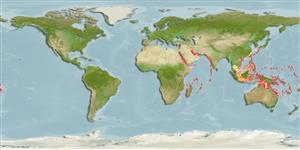Common names from other countries
>
Mulliformes (Goatfishes) >
Mullidae (Goatfishes)
Etymology: Parupeneus: Latin, parum, parvum = small + Peneus, the name of a river.
Environment: milieu / climate zone / depth range / distribution range
Écologie
marin; saumâtre récifal; profondeur 1 - 45 m (Ref. 96856). Subtropical
Indian Ocean: Red Sea into the Gulf of Aden and recorded from Socotra (Ref. 54393). Suez canal migrant and now established in the eastern Mediterranean.
Taille / Poids / Âge
Maturity: Lm ? range ? - ? cm
Max length : 28.0 cm TL mâle / non sexé; (Ref. 2272); common length : 25.0 cm TL mâle / non sexé; (Ref. 5450); poids max. publié: 275.30 g (Ref. 121845)
Épines dorsales (Total) : 8; Rayons mous dorsaux (Total) : 9; Rayons mous anaux: 7. Diagnosis: Pectoral rays 14-17 (usually 16). Gill rakers 7-9 + 23-26 (total 30-34). Body relatively elongate, the depth 3.65-4.2 in SL; head length (HL) 2.9-3.25 in SL; snout length 1.7-1.9 in HL; barbel length 1.4-1.5 in HL; longest dorsal spine 1.5-1.7 in HL; penultimate dorsal ray 1.15-1.25 in length of last dorsal ray; pectoral-fin length 1.4-1.65 in HL; pelvic-fin length 1.4-1.6 in HL. A broad black stripe is present from side of upper lip through eye along upper side of body, ending beneath posterior part of second dorsal fin; body above stripe grayish green, the scale edges yellow; body below stripe white, the scale edges narrowly reddish; caudal peduncle yellow dorsally with an irregular roundish black spot, mostly above lateral line; caudal fin yellow; second dorsal and anal fins with narrow blue and yellow stripes; peritoneum pale (Ref. 54393).
The most common goatfish in shallow water in the Red Sea. Usually found on sand bottoms near coral reefs (Ref. 3470). Feeds on invertebrates that live on sand (Ref. 13550).
Life cycle and mating behavior
Maturities | Reproduction | Spawnings | Egg(s) | Fecundities | Larves
Randall, J.E., 2004. Revision of the goatfish genus Parupeneus (Perciformes: Mullidae), with descriptions of two new species. Indo-Pac. Fish. (36):64 p. (Ref. 54393)
Statut dans la liste rouge de l'IUCN (Ref. 130435)
CITES (Ref. 128078)
Not Evaluated
Menace pour l'homme
Harmless
Utilisations par l'homme
Pêcheries: intérêt commercial mineur; Aquarium: Commercial
Outils
Articles particuliers
Télécharger en XML
Sources Internet
Estimates based on models
Preferred temperature (Ref.
115969): 24.7 - 29.1, mean 27.7 (based on 910 cells).
Phylogenetic diversity index (Ref.
82804): PD
50 = 0.5000 [Uniqueness, from 0.5 = low to 2.0 = high].
Bayesian length-weight: a=0.00933 (0.00524 - 0.01663), b=3.10 (2.95 - 3.25), in cm Total Length, based on LWR estimates for this species & Genus-body shape (Ref.
93245).
Niveau trophique (Ref.
69278): 3.5 ±0.3 se; based on diet studies.
Résilience (Ref.
120179): Haut, temps minimum de doublement de population inférieur à 15 mois (K>1).
Fishing Vulnerability (Ref.
59153): Low vulnerability (15 of 100).
